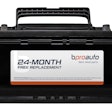A good oil sampling program can do a lot to extend the life of a truck engine but the little thing about the size of a large YETI cup screwed to the engine oil circulatory system is a vital link in the chain.
Oil filters catch contaminants that could damage the internal components of the engine. In order to capture such particulate, Luber-finer Senior Product Engineer Zafar Hussain says filter manufacturers have developed high-performance filtration media to achieve higher levels of cleanliness.
“Media has changed a great deal through the years, from the original ‘sock filters’ to cellulose – paper-based – media, to micro glass media, and now to the fully synthetic polymeric micro fiber media,” says Jonathan Sheumaker, Cummins Filtration’s technical adviser for liquid filtration research and technology. “Each of these media technologies has brought a decrease in fuel-economy-robbing restriction and an increase in engine-wear-reducing particle efficiency.”
Oil filters feature a fairly universal design but fleet equipment operates under anything but universal conditions.
Newer engines run at higher-than-ever temperatures and some fleets are pushing oil drain intervals up to two times beyond standard OEM recommendations.
Director of Speedco Operations Aaron Aylworth says he doesn’t believe higher engine temperatures are significant enough to affect the filters, adding “if anything, the intervals are getting longer and not shorter, so there is no reason to believe the temperature has had any negative effect on the filter.”
For fleets on extended drain intervals, Sheumaker says cellulose media and lower quality seals should be avoided.
“Fleet owners who encounter [harsh conditions, a severe duty cycle in certain applications, and increased stress on oil due to strict emission standards] should consider using filters designed for extended life or extended change intervals,” Hussain says. “They can intelligently pick a filter from conventional, extended life or extended life with integrated additives by utilizing oil analysis data.”
If analysis data shows oil degradation or depletion of oil additives, Hussain says the fleet should consider using extended life filters integrated with additives.
“These filters can extend the oil’s useful life by continuously replenishing oil additives or reconditioning oil by linearly adding depleted additives over the life of the filter,” he says. “In certain situations, it is useless to use extended life filters without reconditioning the oil. At the same time, it is useless to use extended life oil without extended life filters.”
Not all oil additives are imbedded in the filter or the oil itself. There are a variety of aftermarket oil additives available, which Aylworth says “effect little or no change to the performance of an oil filter” as long as the additive is fully soluble and compatible with all industry-standard oil brands.
“If an additive is not soluble in the oil, it may stick to the filter media surface,” Hussain says. “This causes higher flow restriction, which may starve the engine from lubrication and may also reduce the filter’s life. There should be no concerns for fleet owners provided they understand the solubility of the additive and its compatibility with the specific oil brand they are using.”
Sheumaker says a fleet may need to use a filter with upgraded seals and more robust media to deal with the extended time in hot engine oil if the OE filter is not already equipped with these features and the fleet’s drain interval is substantially longer than recommended.
“As far as additives go, make sure the additives actually provide a measurable benefit that justifies in the increase in filter cost,” he says.
“Pick the correct filter for the application and make sure to include mid-trip services that include filter changes on extended intervals and you’ll be okay,” Aylworth adds.










